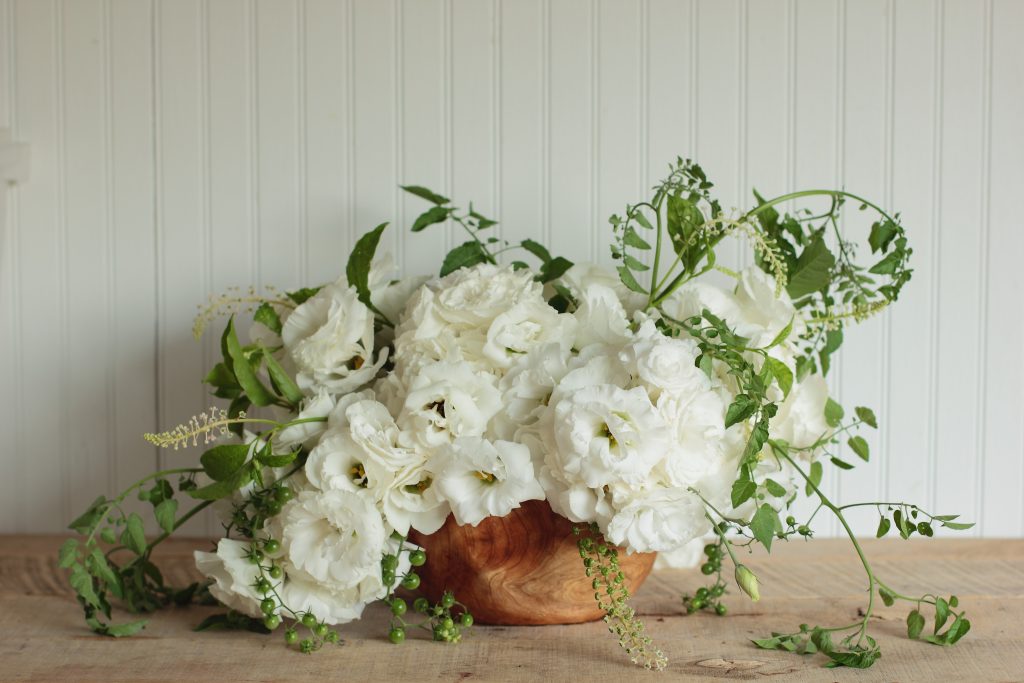
I first wrote a post about tips for growing lisianthus in 2015. That post has since become the most popular one on the blog… actually the top hit for the entire website! And I hear repeatedly from new flower growers about how they’ve found that original post to be so helpful as they tackle growing lisianthus themselves. But I’ve fine-tuned our lisianthus production here at our farm even more over the past three growing seasons. So an update to that original post seems in order! The text that follows is a mix of old and new. Happy growing!
When I first started designing for weddings, nearly every couple asked me for roses. My first season as a farmer florist (way back in 2009), I stuttered a good bit, trying to explain how I didn’t have them because they are very challenging to grow organically in our climate. I didn’t mention that I also happen to strongly dislike roses. Too much fuss, and I hate those thorns! However, I realized pretty quickly that I needed to have a good alternative to offer if I was going to be successful as a wedding florist. Enter growing lisianthus – a far superior rose!
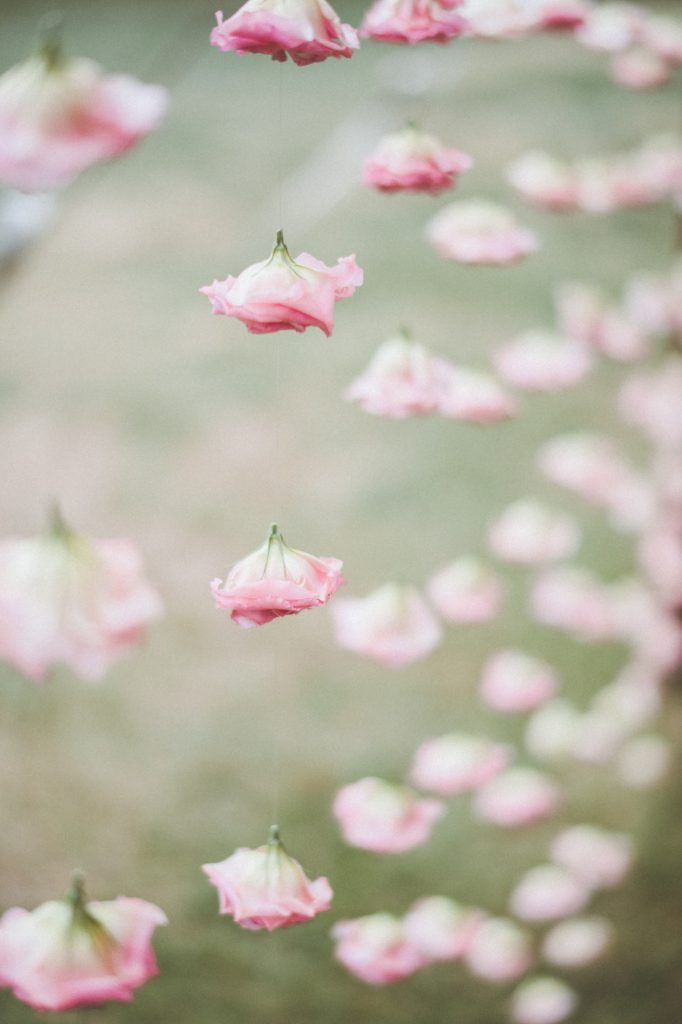
I remember attending my very first ASCFG conference and listening to experienced growers debate the merits and shortcomings of growing lisianthus. I got the decided impression that, while gorgeous and long-lasting in the vase, they were hard to grow. So when I started growing lisianthus myself, I was so surprised at how easy they were!! Lisianthus have consistently been one of our top crops over the years in terms of quantities and profitability, second only to the dahlias. With all the new flower growers out there, especially farmer florists, in their first few seasons at the moment, it seems like a great time to demystify this crop that really is ridiculously easy to grow with a few tried-and-true tricks up your sleeve.
It is important to note that all our lisianthus at Love ‘n Fresh Flowers are grown in the field. You do not need a greenhouse or tunnel to grow beautiful lisianthus! However, many growers do grow them under protective cover in areas that receive a lot of rain and/or do not have particularly hot summers. When it comes time to flower in the summer, lisianthus like it dry and hot for best quality of blooms. They originated as a prairie wildflower so that gives you a clue about what conditions they prefer. Fun fact: lisianthus are native to the United States!
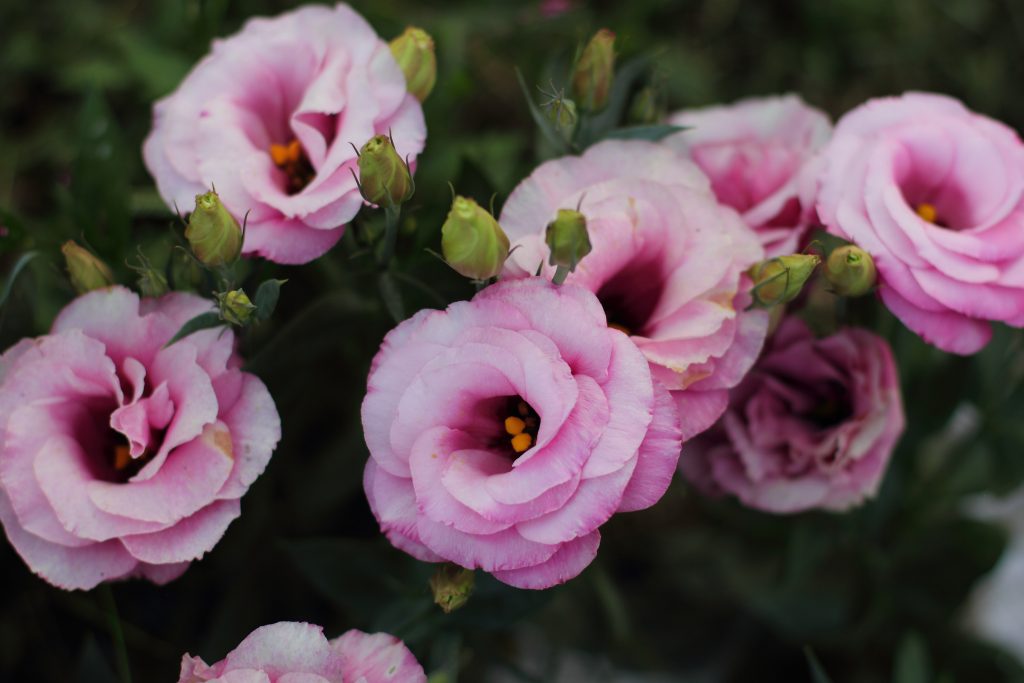
Five Tricks to Growing Lisianthus in the Field
1. Plant Early
Just about everyone knows how slow growing lisianthus are. If you don’t, you’ll soon find out with your first crop. What is maybe less common knowledge is how cold/frost tolerant lisianthus are since these blooms are often associated with the high heat of summer. While the plants love the heat to throw up their flouncy blooms, they actually also love cool temperatures for putting on root growth, which is what ultimately supports tall and bountiful harvests.
As such, we are religious about putting our lisianthus in the ground, out in the field, on April 1st each year, regardless of the spring conditions. That’s about 2 weeks before our average last frost. The tiny rosettes hug the ground and therefore are pretty well protected against freezing and frost. If the weather is particularly nasty, we will cover them with a layer of frost blanket, but that’s rare.
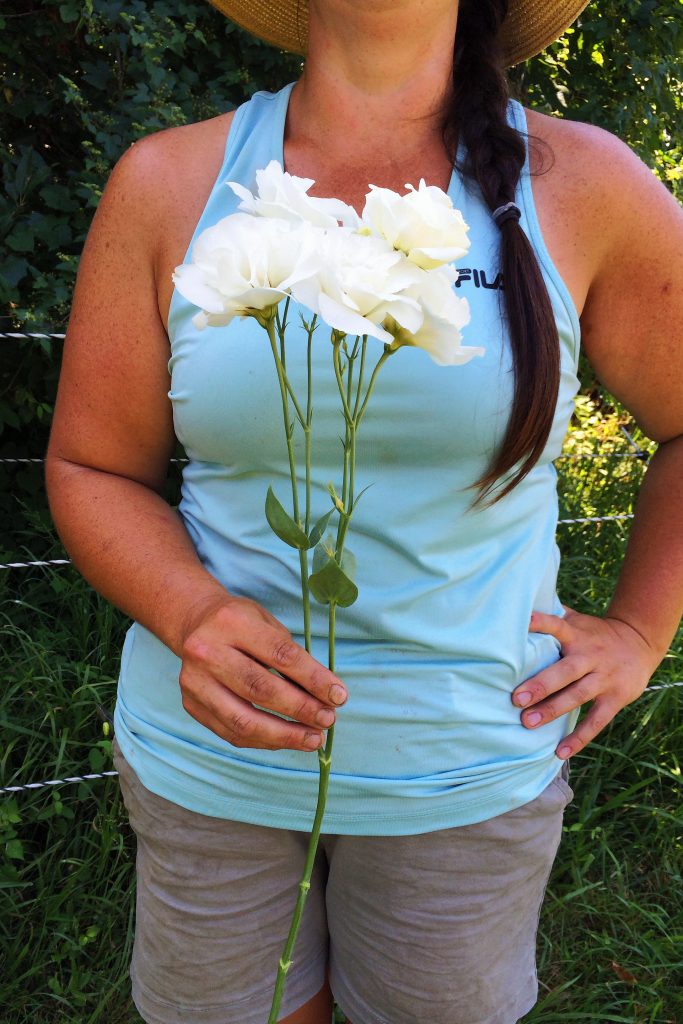
UPDATED: The spring of 2018 was an incredibly wet one and we lost quite a number of our lisianthus to rot at an early stage. Moving forward, we’ll have short wire hoops over the newly planted lisianthus with a layer of plastic at the ready to shield them from heavy rain until they have their root systems well-established. The plastic will always come off on nice days as we don’t want to get the young lisianthus hot in the spring, but we do need to do something about all the rain!
To get them in the ground April 1st, we make sure to talk to our plug broker in November so the plug grower has enough time to get our plugs going. While we historically have grown 99% of what we have at the farm from seed ourselves, lisianthus is the one crop that I will never bother to grow from seed again (I did for my first season, but never again). Instead, we get our plugs from our supplier the last week of February or the first week of March in 210s and typically bump them up to two inch soil blocks or #72 trays as soon as we get them and grow on in those for a month until planting out. If you do not have a greenhouse, you could order the #128 tray size to arrive right before you are ready to plant and put them directly in the ground.
This early planting date gives the plants plenty of time to put on growth before the heat of summer and also gives them a bit of an edge over those tenacious summer weeds.
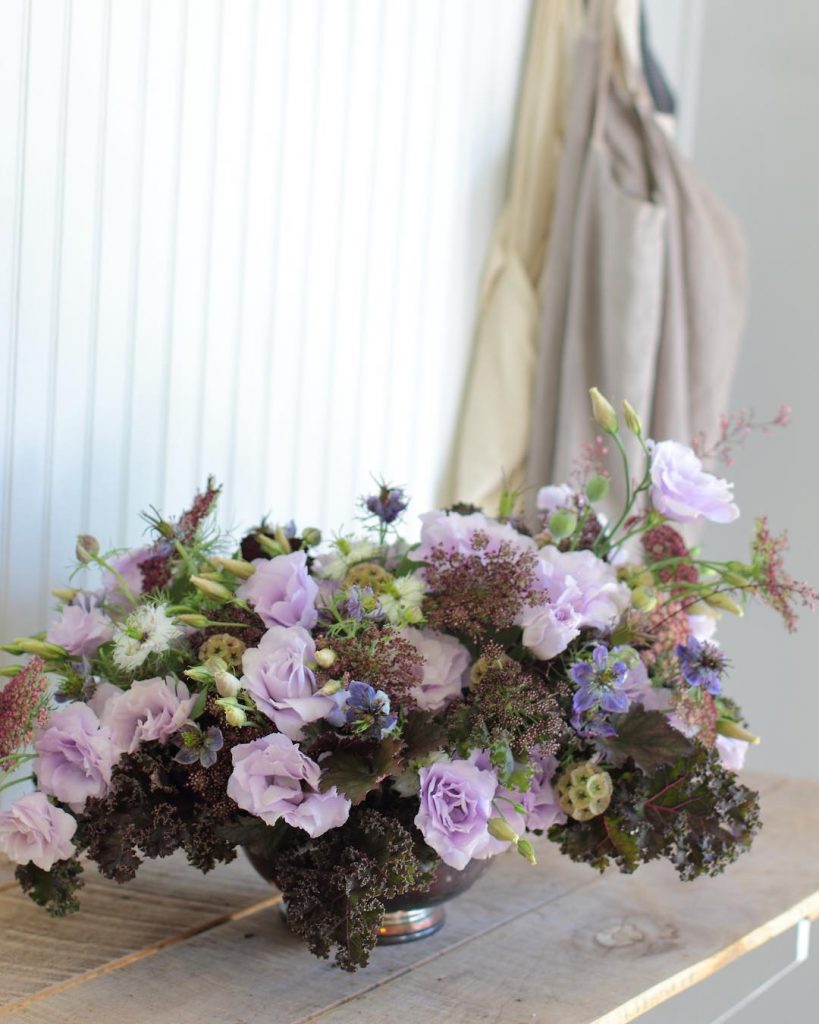
UPDATED: I’ve gotten asked a lot about where to source lisianthus plugs. We get ours from Gro ‘n Sell based just 20 minutes away from us here in Pennsylvania. They always grow incredibly high-quality plugs and are committed to using sustainable practices, particularly IPM, whenever they can. We place our orders through Farmer Bailey’s site, but there are several other brokers who can help you place your order if you’re already working with one (i.e., Rakers, Gloeckner, Harris, etc). Please note, this is a wholesale grower/broker situation that we are using. So to do the same, you’ll need to have a business license to set up an account and be willing to order several hundred plants. We typically order about 1500-2000 lisianthus plugs each season from Gro ‘n Sell.
If you are a home gardener interested in growing lisianthus, you’ll have better luck looking in your local community for an outstanding, independent garden center and asking them if they carry lisianthus. If they don’t, you might want to tell them about this blog so you can start growing lisianthus too!
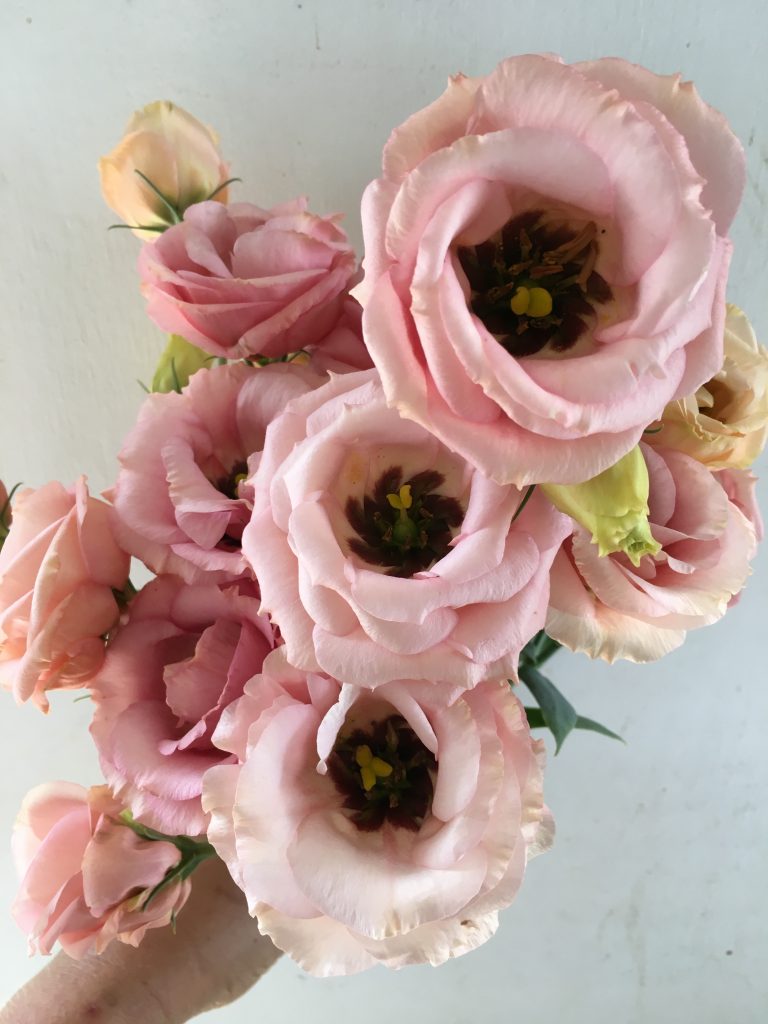
2. Weed Management
Speaking of summer weeds, if you’re going to grow lisianthus, you need to have a serious weed management game plan in place for them! Because these plants stay small for several months and the leaves are at the base as a low-growing rosette, aggressive weeds will quickly overtake plants and smother them. Creepers like crabgrass are particularly tough when growing lisianthus.
Lisiathus is a high value crop worth investing in so I gladly pay for a plastic mat system called FloraFlow that comes with uniform pre-punched holes that are only two inches in diameter so there’s very little room for weeds to grow up though the holes. It also keeps the lisianthus cropping system very tidy and efficiently spaced as a whole so we can fit a lot of plants into a small amount of space. You can space lisianthus plants as close at 3” on center. When we’re really tight for space, we even put two plants per whole and they still seem to produce well (enough).
But plastic is not a silver bullet for weeds. We make weeding the lisianthus top priority around the farm. It’s much easier on us and better for the crop if we weed early and often rather than waiting until the situation is dire and we pull up as many young lisianthus as we do weeds. So put some reminders on your calendar to get those lisianthus weeded at least every two weeks if you have decent weed pressure at your farm. Make sure to water well immediately after each weeding so that the delicate roots get re-settled into the ground.
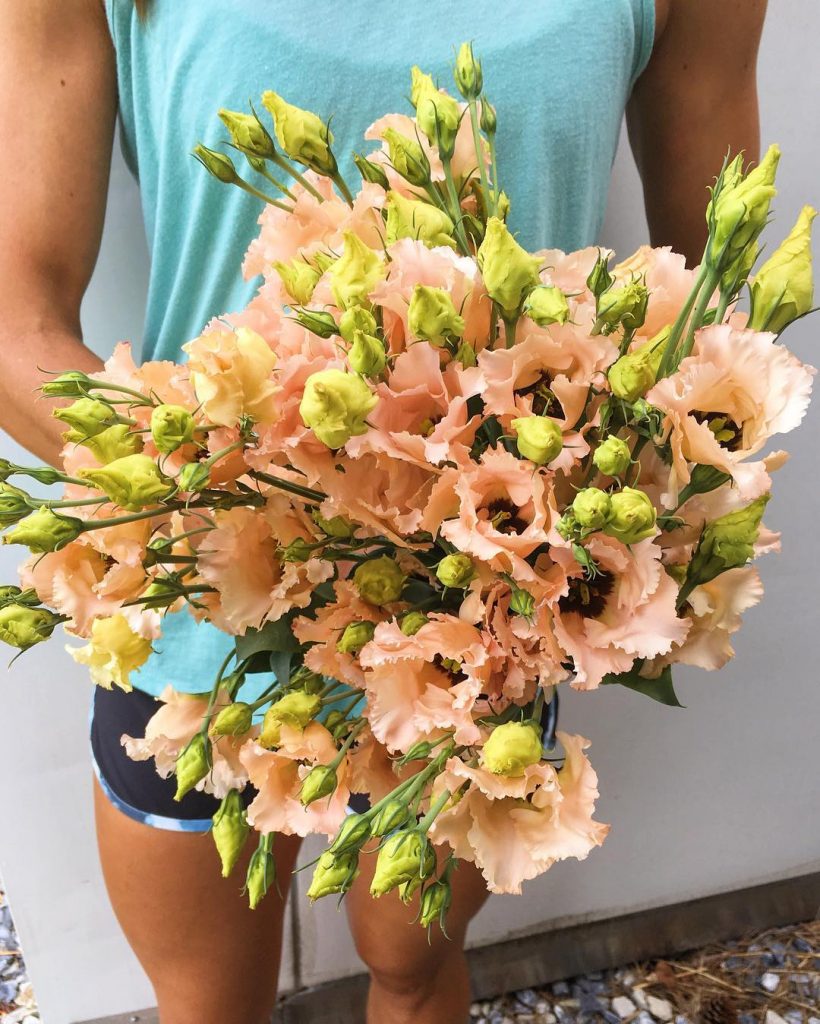
3. Watering and Feeding
When prepping the lisianthus beds in the spring, we amend them with compost, cotton seed meal and green potash. We have a really nice loamy clay soil at our farm that the lisianthus love because it holds water and nutrients well, but does not stay wet. I suspect that growing this crop in sandy soils or heavy clay might be more challenging, but I don’t have experience with that.
After planting, we do a weekly foliar spray of an emulsified mix of fish powder, bat guano, and kelp powder. This seems to be a good balance feed to keep the lisianthus healthy while they put on their roots through the early months.
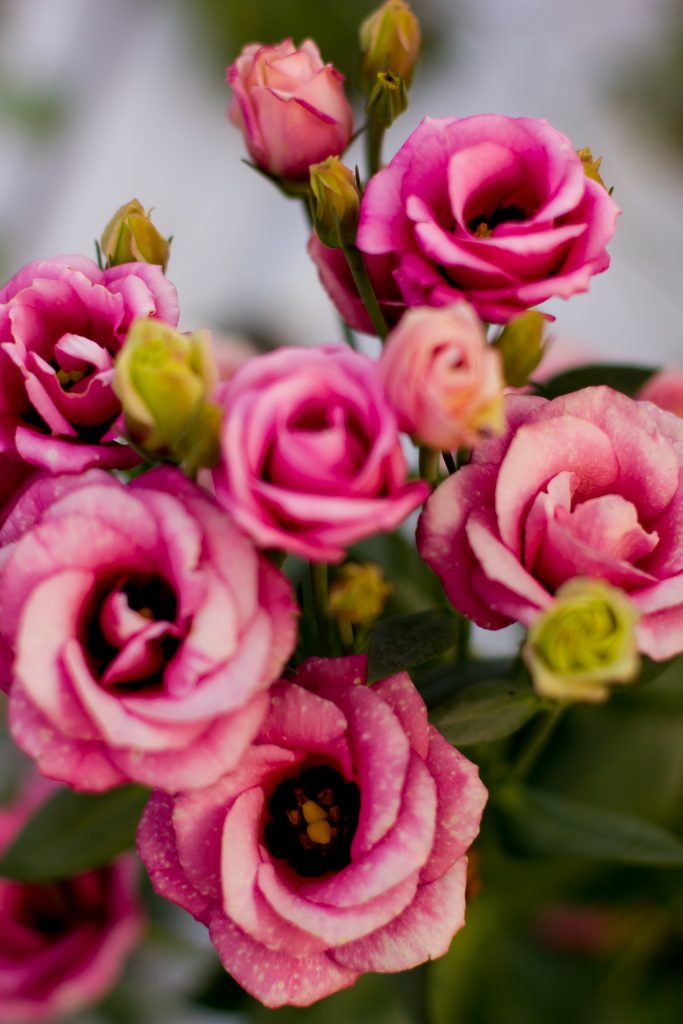
UPDATED: If you are using a similar foliar application as we do, it’s best to spray right after the lisianthus are weeded so you are not also spray/feeding the weeds and shooting yourself in the foot. We only spray the plants when they are not flowering. Once the lisianthus have developed plump buds, we stop spraying since the blooms get discolored if any of the spray gets onto them.
Also, it’s important to use drip irrigation when growing lisianthus. The flowers do not like getting wet and are prone to spotting and/or molding if you water overhead with a sprinkler or hose. For this reason, it’s also important to keep an eye on the forecast when your lisianthus are in bud. If a heavy rain is coming the next day, it’s best to get those lisianthus harvested the evening before so the blooms don’t get saturated!

4. Variety Selection
UPDATED: Before you start drooling over every cool lisianthus photo on Pinterest, think carefully about who’s going to be buying from you. We use all our lisianthus “in house” here at Love ‘n Fresh, mostly for weddings and occasionally for straight bunches sold through our grocery store accounts and in our CSA bouquets. As such, we have the luxury of being able to grow some of the shorter varieties that hold up better to bad storms and do not need netting. We also grow some of the oddball colors like Roseanne Brown and Doublini that work well for weddings but would not pass mustard in retail.
If you are selling wholesale to florists, you will be expected to grow the taller varieties since stem length (sadly, in my opinion) means more money. If you are selling to florists, I would stick with the ABC series and then try just a few specialty varieties like Roseanne Brown and Coreli Light Pink until you see exactly what your florists want.
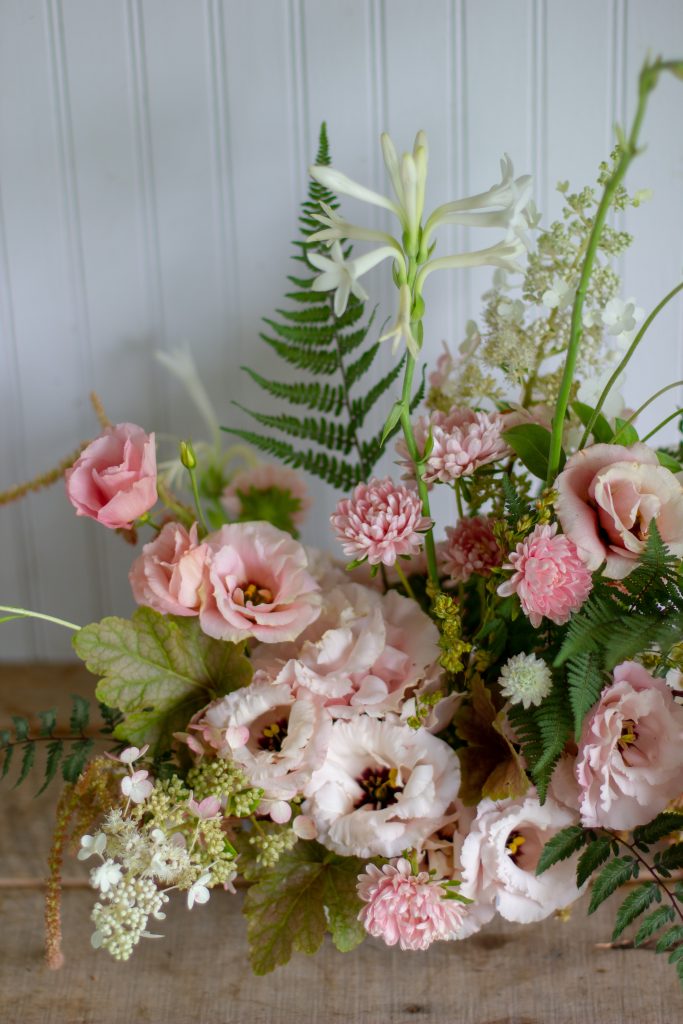
If you’re selling mostly at a farmer’s market, you should avoid Roseanne Brown because all your customers are going to think it looks dead (and frankly, it does). I’ve always found that the brighter/saturated colors of lisianthus sell best at market, so stick with bright pinks, deep purples, and maybe try a few Roseanne Green if you want to spice it up a bit. But, really, steer clear of anything too “funky”. Farmers market customers generally aren’t interested in funky; they want easy, fun, cheerful bouquets.
Something to also consider when choosing lisianthus varieties is if you want to net them in the field or not. I’m going to be honest: I hate netting. We’ve completely stopped using it at our farm at this point. It’s expensive, both to purchase and to put up every season (mucho woman hours) and it makes harvesting so much slower and often a bit wasteful with all the broken stems, especially when it comes to brittle lisianthus. So we’ve been net-free on our lisianthus for five seasons now. This means that some old favorites have been given the boot (ABC 3-4 Pink, I’m looking at you) and a lot of new varieties have been trialed specifically to find out if they’ll stay upright on their own, even in our wicked summer storms here in the Mid-Atlantic. Some varieties that have done particularly well for us without netting are ABC 3-4 White, Falda Salmon, the Echo series, Arena Apricot, Corelli Light Pink, the Doublini series, and the Rosanne series.

Like snapdragons, lisianthus are segmented into bloom-time categories so you will sometimes see numbers associated with variety names (i.e., ABC 3-4 White). Also like snapdragons, I have found that attempting to “program” blooms in the field is much harder than it would be in a greenhouse, which is where that number system were developed. Inevitably, your lisianthus are going to bloom pretty much all at once when field grown, even if you did try to succession plant them for staggered bloom times. Be prepared for this with a sales outlet eager to buy them as soon as you pick them.
A note on storing cut lisianthus: They do not like a cold cooler. In my experience, it’s best to store them around 42-48 degrees if possible. They resent being much below 40, and if given a choice, I’d rather leave them out in the shade of a tree or in a cool basement instead of a cooler below 40. If stored properly, we can generally keep them in the cooler for up to 2 weeks until we use them in our floral designs for weddings. I would say storing them for a week in a cooler is still fine for selling them at farmers markets or to florists. So if you have a sales outlet ready in a week but you see big storms rolling through soon, get out there and pick those lisianthus and store them rather than letting them on the plants to get hit with heavy rain!
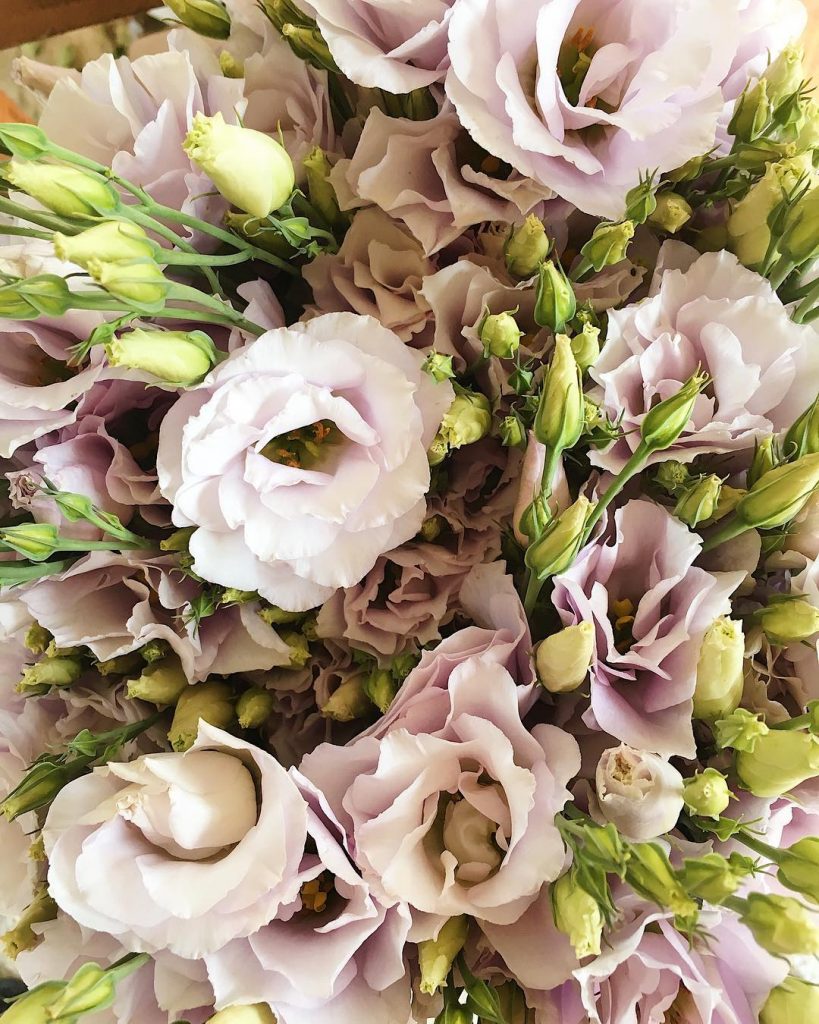
5. Second Flush
Assuming you were diligent in getting your plugs into the ground in early April, in the Mid-Atlantic area (we are zone 7 here) there is a long enough growing season to get a very nice second flush off of your lisianthus, usually sometime in early to mid-September. The first major bloom happens in mid-July. But this second flush is particularly welcomed at our farm since it’s perfectly timed for our very full autumn wedding season!
To get a good second flush, you need to do a few important tasks. First, when you harvest the first flush of blooms in July, make sure you are cutting the plants back almost to the base. Do not leave stumps of stems that will just result in weak secondary growth.
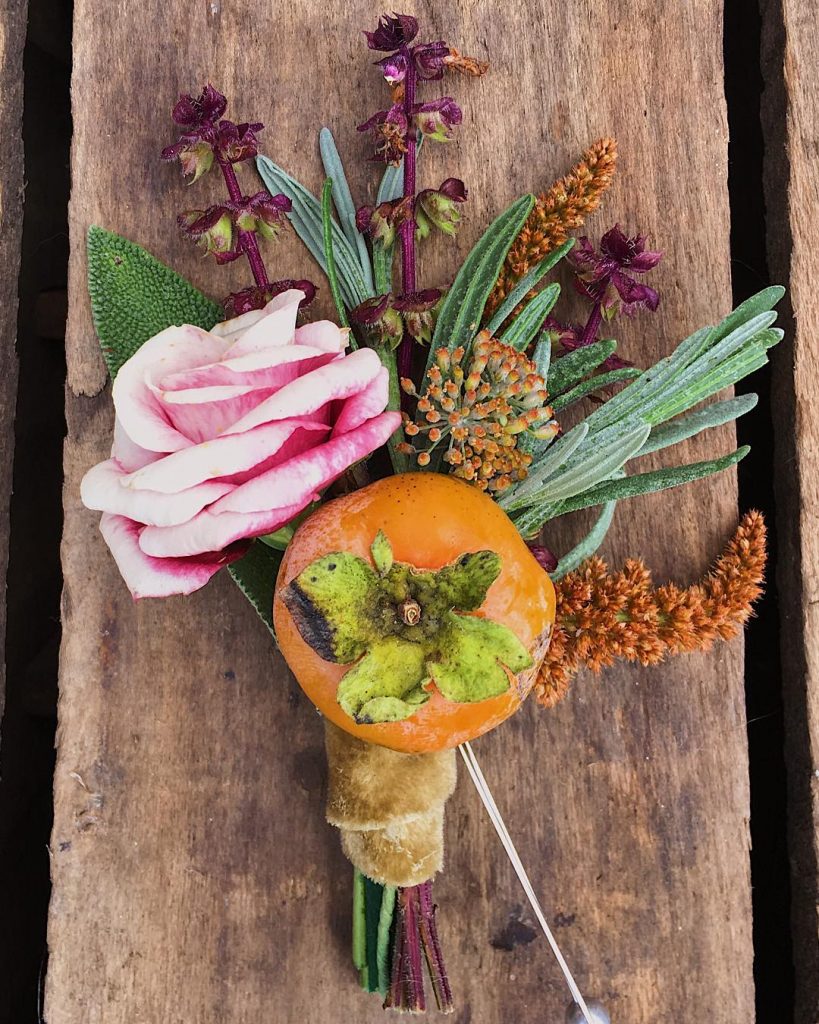
Once you’ve gleaned all of your first flush of blooms, take time to thoroughly weed the bed, irrigate, and fertilize, ideally all on the same day. This gives the plants a huge boost and the signal to go ahead and put energy back into putting on new growth instead of shutting down. Then remember to be diligent about weeding every week or so thereafter. At our farm, we have to battle the crabgrass in particular in late July when it’s rampant.
Remember to keep your lisianthus irrigated while it puts on this new growth in the heat of late summer, especially every time after you weed. As the plants grow for the second flush, we return to our weekly foliar applications, which really helps those new stems get taller. Any and all TLC you can give the lisianthus while they put out the second growth will result in taller and more plentiful blooms in September.
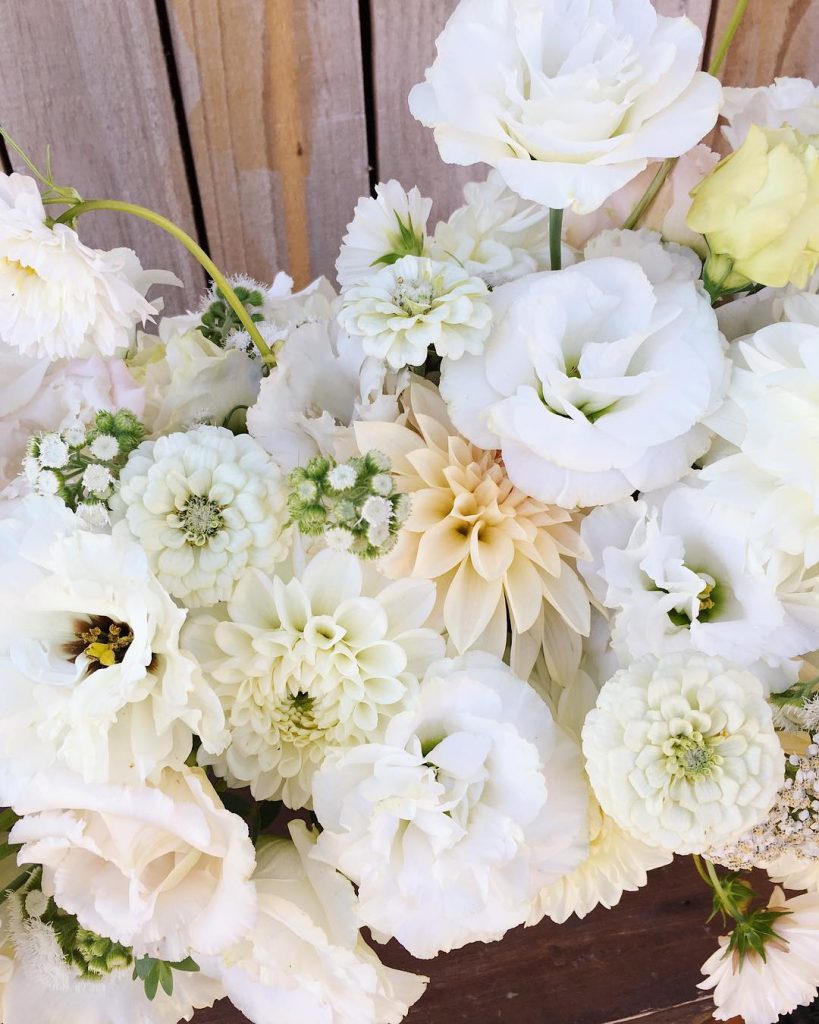
So, what do you think? Will you be growing lisianthus this season? I hope I’ve help make them much more approachable! And you can find out a lot more advice about growing lisianthus and every other flower by joining the Association of Specialty Cut Flower Growers, an amazingly generous group of professional flower farmers who are happy to share advice!
For more flower farming tips, be sure to check out this past post on Growing Ranunculus and Anemones in Zone 6b/7 or this previous post about my Five Favorite Native Perennials for Cutting.
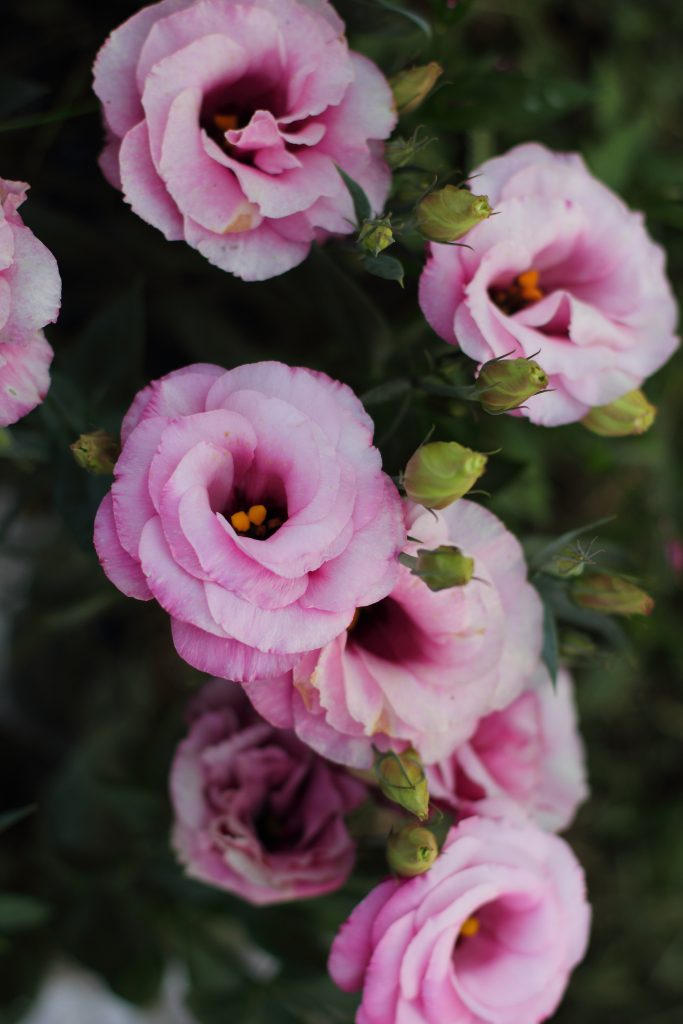

Very informative!!
Do you also have the same for care and handling for the cut flowers? By the trade and consumer??
Hi, im from down under, an Aussie, Sunshine Coast I have fallen in love with lisianthus. I live in the same climate as Texas, I think, never seen a drop of snow ever here, so hot and humid in summer, 37 cel 98.6 F. winter we have a top of 24C 75F. I discovered lisianthus on Korean drama, thought they looked like a rose but better. Just wanted to thank you for your information on growing this flower. Will cover with plastic from our tropical rain. Im trying to grow from seed which will take 6 to 8 months if they do at all. Worth giving it a go, Thx again Kerry Reed
Hi Kerry,
I too live on the Sunshine Coast and wanting to grow Lisianthus. My packet of seeds says to sow Aug-April but I’m considering sowing them now because it’s been so wet I’m worried they will rot before we get a chance to enjoy them next summer. When will you be sowing? Thanks!
Hi Jennie Thank you so much for this blog. I am an Australian grower too – first year with a substantial planting of enough to sell (hopefully)! I grew these for my mother in law and fell in love with them. I am near Kerry and Nicole, just West of Gympie. I am growing Lisianthus too and would love to compare notes. I sowed seed in April but have not been able to germinate it. I am growing from plugs as well. The information in this article has been helpful and I am now less fearful of planting these out given that we can sometimes frost heavily. This has been an unusually wet year but I am crossing my fingers what I have will still florish.
Hi Jaime,
Just saw your post. I have 6 Lisianthus plants in the ground growing now. All from seed but gosh so slow. Where did you get your plugs from please? Would you be interested in sharing orders from wholesaler at all?
Hi, thanks for sharing. This page is really help! I also have plant some of lisianthus. However most of them are rosette. They keep tiny And produces basal cluster or leaves. I’m a home gardener and this is my first time planting this flower. From 39 sown seeds (5 palleted seeds and the rest are from their organic seeds), i’ve got one that success to bloom. It comes from organic seed. I’d love to try planting it again! However I think it’d be difficult since i live in the tropical area. Growing and getting one blooming lisianthus is really such a miracle. Greeting from Indonesia!
Thank you so much for sharing all of your valuable knowledge. I fell in love with these little gems two years ago, grew again last year, and have sowed almost 500 this year. Your tips are generous, and your heart is giving!
This little garden plot grower and designer loves following you
Excellent information! Thank you!
Quick note – we planted our plugs straight into mud in our heavy clay soil after it wouldn’t stop raining for 2 weeks. It was February (zone 8) and they were larger roots – 125 tray size. Eventually, they did AMAZING! huge, prolific, amazing. It did stop raining after another week so we squeaked by without rot. (also the rows were raised). In case anyone reading is curious 🙂
Thanks for sharing, Sarah Jo!! The more info we can all compile here, the more we’ll collectively know. 🙂
Hello! Do you know if it is possible to propagate a stalk of Lisanthus? One of my mine broke off in some heavy rain and I want to replant it if I can. Would root growth hormone work?
I’ve never tried rooting a piece of lisianthus. I’m not sure that it would work, but it never hurts to try!
I pruned my lisianthus in the greenhouse and was curious if I could put them in a tray and root them. Much to my surprise, they are doing great. I have a short growing season in zone 4a, so not sure there will be time enough to grow a good root system and still have time to flower, but you never know,
Last year I bought 6 Lizianthus plants at the local nursery and pinched them in half and they all propagated and 12 plants bloomed great. So I do know for a fact that they can be propagated. I keep asking myself if this is a healthy and ethical practice and I really don’t do it much outside of my garden. I know with some plants if you are selling you need to be sure that you are allowed to propagate them. I see that with ranunculus plugs … a company I used … states do not propagate. So maybe it just comes down to that. I also wondered if I had let them grow without propagated them … would they have been taller stems. So that is my first year experience. Mine where planted from seedlings after mothers day and bloomed in mid august in my 4a zone. They bloomed at different times, but within a week of each other.
I bought 5 plants from the farmers market , no matter what I do with them they just want to wilt. I planted them in and even covered them on hot days. Very disappointed in them. What should I be doing with them?
Bought 5 lisianthus plants at farmer market. Planted them in and they are constantly wilted. Do not know what to do with them anymore. Even cover them on hot sunny days, but I think I will lose all 5. Very disappointed. What can I do with them?
Thank you for this wonderful article. I love licianthus so much and I’ve been trying to grow it from seeds but the servings are taking forever to grow.
Love your article. We plant lisianthus but usually only go for one cutting due to the thrips pressure and the Tomato Spotted Wilt Virus (TSWV) being endemic to our area. We can reflush sometimes once while the weather is cool however with the Spring and Summer temperatures the thrips go crazy as well as the TSWV. Some wholesale customers seem to like the weird colors like Brown and Antique purple and green to a point but we usually plant at least 40% white and 25% purple and than scatter the rest among the other colors. We are trying to schedule plantings throughout the year to try and produce inside our hoop houses as well as within a greenhouse area we are hoping not to have to heat as our night temperatures are not particularly cold in our locale and natural gas prices can be a pain. We do plant more densely as we cannot depend on getting a second crop and plant in wire mesh at around 8 to 10 plants per square foot to maximize the space production.
Thank you for the beautiful post on Lizzies (my affectionate word for Lisianthus). I have been growing these beauties for the past 10 years. I start 800-900 plants by seed in my basement every winter. I am hopelessly addicted to them!
I don’t sell them, but love to give them away. I am curious if you know what pest kills some of the buds? I noticed that some of buds turn brown (before opening) and die. I’ve often wondered what it is and what I should treat them for? Any advice would be so appreciated :).
That sounds like a fungus issue, likely botrytis. There are various sprays available for that if you do a little research online. What you’ll have access too depends on your location and if you’re a professional grower or a home hobby grower. 🙂 Hope that helps!
Kim, what is your secret to starting the seeds yourself? I have always bought plugs, but am determined this year to try seeding them in my basement also.
Any good tricks for starting from seed?
I’m not Kim, but I start Lisianthus from seed, too ….mine are poor country cousins to the ones Jeannie grows, tho. The trick is bottom heat, a single community pot (one pot per variety) and a thin mil plastic bag over the top. Several ways you can do this… one is a lightweight ziploc sandwich bag over a 3” pot with about 10-18 seeds in it, the other is a small clear trash bag/dry cleaning bag over an entire flat, held up and off the seedlings by garden stakes, or a clear plastic dome. Do not use freezer bags, which are too thick. Because these seedlings are so tiny, start them around Thanksgiving on a heat mat somewhat close to the lights. If they have a little elbow room in their community pots, they will stay there for a good long while! Slow! As was stated in the article, they can take the cold, and in fact I think they are one of the 30 flowers Lisa Mason Ziegler has in her book, Cool Flowers, and that people in Z8, maybe Z7, can plant them in the late summer or fall with a row cover for bloom the following spring. (I can’t find my book right now, so double check that, ok?) I really, really would like to upgrade, because these fancy doubles are every bit as pretty as roses!
Hi Suzy. When do you take your lizzies off the heating pad? And when do you plant outdoors? What is your spacing when planting outdoors?Thanks for your info, almost ready to try growing them.
First year when I am trying liziies from seeds. Every year I try a challenging flower to keep me going during the long winter. I am zone 5, Canada. Started 200 seeds thinking I will get a couple going but surprisingly almost all made it. Started them January 11 with a heating mat under lights. For 2 months they were extremely tiny then the leaves started growing. Heating mat was on for about 3 4 weeks only. When I reported 3 month later, out of the trays into 2 inch pots, they were tiny but had couple of leaves. Ran out of pots and potted 10 in a 5 inch pot. All survived, they are still under lights. It is May 7, 2 weeks before my last frost date and I am planning to transplant outside. This post helped me a lot. Looking forward for the flowers. My plants are only 2 to 3 inch tall now.
I dislike the dreaded fungus ants and I believe they hatch on the top of the soil. I guess they may have a purpose, but it is such a horrible ordeal to deal with. So if they start to show … let the soil dry a bit more than you would plan too. The larva eat at the roots and they only are on that top layer where they are laid by the nat. Each year I get the fly sticks and hand that to get rid of adults — then I found that 1 part peroxide to 8 parts water sprayed onto the top layer will start to end the process quick. I started this in 2019 and it has been very helpful for me.
Thank you Jeannie!
Thanks for the information. I will try them this year since I am in zone five
I love Lisianthus. I’ve been growing them for almost 20 years. I do order them from a plant catalog. I’ve never tried them from seeds. Always get a lot of compliments on them. One lady walking by my house saw one growing in my garden and thought it was a rose. Lot of good information here.
@Chris Grunberg…what catalog are you ordering from ?
Thanks!
Just saw your comment. I order from Burpee catalog. You get 18 plants.
Hi Chris. I too ordered 18 plants from Burpee. They arrived in a 2″ cell pack with 2 leaves on each plant in March. I transferred these to 4″ pots and after these were about 8-10″ tall, I planted them in their permanent home. Burpee did not say to pinch these plants to make them bushier. I read another article that said to pinch the plants back at 6″ high or after three pairs of true leaves. Unfortunately I did not read this in time so all 18 plants are on single stems. Can anyone tell me when to pinch back these plants? Thanks so much! Dee from Zone 9
We do not pinch lisianthus here at my farm.
I just saw you post. I’ll try this again. This is the 3 time I tried to post this. Janine L Lidell- I order them from Burpee catalog. You get 18 plants.
Do you find that insect pressure is greater when trying for a second flush of flowers?
No, we never have any insect pests on our lisianthus.
We have terrible problems with thrips in the open flowers that make them unsaleable do you have any suggestions? I know that some sprays can burn the flowers but the thrips pressure is too intense.
I’m afraid that I do not have any suggestions for a spray for thrips. Our farm is Certified Naturally Grown so we do not use any sprays for pest control and instead rely on a balanced ecosystem with lots of “good” bugs to combat the “bad” ones. You may want to join the Association of Specialty Cut Flower Growers (ascfg.org) if you haven’t already to ask other professional growers what they do for thrips. Best of luck!!!
I have had some success using Neem oil spray mixed with dish soap concentrate to help reduce thrips which get really bad late summer here in Phoenix, AZ. They do affect the lizzies I’ve been growing some but the roses are always the worst. If done right it doesn’t reduce the good bugs too much. Only spray without any sun and haven’t tried spraying on the lizzies yet. Thanks for the blog! Thinking of propagating some lizzie cuttings I just took and this has been helpful.
Do you use shade cloth to shade sun and also block rain on blossoms? The plants are super hardy and do really well, but I want to lengthen the stems and also avoid drops of water on the petals, which sometimes discolor the blossoms. Any suggestions> Thanks for the excellent information!
Do you pinch the center bud or let them all grow as is?
My farm is (typically) focused on wedding designs. So what we do with lisianthus is tailored to that. When the first flower opens on a stem, we cut it out from the main stem and we use these “shorties” to make boutonnieres, hair crowns, corsages, etc for our weddings while the remaining buds on the main stem continue to mature and plump before we take the entire stem then once there are two more blooms open on it. Hopefully that explanation makes sense. If you don’t need short little blooms for wedding designs, then I’d suggest just leaving that first bloom on the stem while more open up and then at the time of harvest, quickly snip out the older spent bloom, which will look ratty and tired by that point.
Thank you for another really terrific post. My (first time!) seeds have germinated and beds are prepared, so all of your instructions are going to be put into practice in my zone 7a Mid-Atlantic over ambitious home garden 😉 Buckets of gratitude for all that you share!!
I am in upstate NY…typically a zone 4 due to elevation.. we have family farm with greenhouses. this year i have several customers asking for me to start lizzies. for their cut flower businesses.since my plugs will be coming in late march..how do i manage them as i grown them on.. in 4 or 6 cell packs.. or in 4 inch pots.. i would care for them with pansies and violas so they will grown in a cool house.. last frost date usually late may early June any advice is greatly appreciated since this is new to us!
Hi there, thank you so much for your wonderful information on growing lisianthus. I am going to try for the first time this year. I’m wondering if you would share your recipe for your foliar spray? Or is this something you can buy from a store?
Thanks
Hi Michaela, I’m not Jennie with all her amazing knowledge & advice, but I do know you can search for organic compost tea to make a diy folier spray or purchase on Amazon Malibu Compost 100507246 Biodynamic Compost 12 (1ea= 4/Pack) Hydroponic Tea Bag, 1 lb
Where can I buy the lisianthus ABC series for home gardeners. I really like the misty pink and misty blue
We sell plants through our farm in the spring. Unfortunately we are already sold out for this year. Otherwise, I don’t believe these varieties are available to home gardeners.
Hi! Thank you for sharing all this wonderful information! I was looking over the plastic watering system you use, and I wondered if there plastic may cause the soill to overheat, thus damaging the plants. I live in zone 5b, and summer days can greet over 100. Is this a concern? Thanks!
Have you ever tried spraying Spray ‘N Grow on Lisianthus or other flowers? I originally found it in Organic Growing Magazine 40(!) years ago. It really improves everything I spray it on, including dahlias and petunias. I wonder if it would spot the lisianthus flowers. It does not spot dahlia flowers.
Great article!
I have not tried that product. Thanks for the comment!
Hi, do you know which lisi is pictured under the #3 feeding and water heading? The bold pink one? They are stunning.
Can I cut down this plant and over winter in a garage where temperature is kept above freezing?
We are in Saskatchewan, Canada.
Hi Sharon – I’m just a home hobby grower in Maine, far from expert. Last year I dug up a few lizzies and potted them. They survived nicely (maybe 6 out of the 9 or 10 plants) in my sunroom at normal room temp, and this year when I brought the pot outside, they grew and flowered. I figure it’s worth it (since they were already in a nice pot, didn’t need replanting, and they bloomed a little earlier). I don’t know how they would do in a cold garage but you have me thinking… Anyhow, I’m going to try it again this year with lots more plants from the garden – maybe in 3 inch plastic pots and then I’ll plunk them in the ground in April. But I will also start new plants from seed. The business owners who grow tons of these couldn’t do it, of course. But for a few nice plants, just treated like a houseplant through winter, this was worth it and fun for me.
I did this last year. I didn’t cut them down, just dug them up around the root system and put them in pots. I kept them in the attached garage, where it’s warmer than outside but still pretty cold. I watered occasionally, just a little too keep them from drying out for too long.
Toward the end of winter the stalks & most leaves looked very crispy & totally dead. I left them alone and started watering again in the spring and to my surprise, the dead stalks & leaves slowly turned green & pump, working their way from the bottom up. I had no idea plants could revive themselves this way! I replanted them after the last frost and 3 out of 4 survived.
Hi Sharon – I’m just a home hobby grower in Maine, far from expert. Last year I dug up a few lizzies and potted them. They survived nicely (maybe 6 out of the 9 or 10 plants) in my sunroom at normal room temp, and this year when I brought the pot outside, they grew and flowered. I figure it’s worth it (since they were already in a nice pot, didn’t need replanting, and they bloomed a little earlier). I don’t know how they would do in a cold garage but you have me thinking… Anyhow, I’m going to try it again this year with lots more plants from the garden – maybe in 3 inch plastic pots and then I’ll plunk them in the ground in April. But I will also start new plants from seed. The business owners who grow tons of these couldn’t do it, of course. But for a few nice plants, just treated like a houseplant through winter, this was worth it and fun for me.
Curiously enough we have some flowers on our kitchen table that were cut two days after the temperature dropped to minus 8 Celsius (17 F). We had removed most of the plants, but have left two to see how they do over the winter. Right now they are sitting proud sticking out through the snow. (Zone 3). If by chance they do survive the winter, i’ll post again in the spring.
Hi Jennie,
I was wondering if you could give more details on the foilar spray you use on your lisianthus…steps in making it, where you get your ingredients and the ratio of each ingredient. I’m going to try lisianthus next year and I’m doing all the research I can now! Thank you so much!
Put my very small seedlings in the ground March 10th. Zone 8 Coastal Carolina. They already had great roots. Have covered on two nights with frost. So far…so good. Thank you for all the great information. Not sure if I will grow from seed again but had to try at least this one time.
Thanks so much for this information! Super helpful:)
I’m wondering whether you pinch your plugs? And if so if you have any advice about how, when etc?
Thanks so much for any guidance you can provide.
Bianca
Hi Bianca – I don’t pinch lisianthus. Many growers do but I prefer the super long stems that unpinched plants produce. So I’m afraid I don’t have any solid advice to offer about pinching.
We received about 30-40 plugs from a local florist here in the Pittsburgh area.
If we plant them 3″ apart, do we later thin them?
Do the deer and bunnies eat them?
If so, I’ll plant them in my Vege area which is fenced
In any event, thank you for this informative article.
This year, I grew some Lisianthus from seeds collected from cut flowers. This year I also bought 4 varieties and now hope to collect seeds for this year. The fungus gnats were my biggest enemy while trying to grow these indoors over the winter months. I did use a heat mat and covered the seed trays with plastic.
Thanks for the informative article!!
Hey! You came up on a Google search and I quickly realized you’re basically my neighbor. I grew up in NE Philly 🙂 currently in DE. I tried looking up the place you purchase plugs & they say you have to use a broker to purchase… do you have any recommendations?
I’m military & I want to be a flower farmer when I grow up (retire, hahaha).
Thanks!
Nice to meet you, Christine! We sell cut flower plant starts at our farm in spring and fall. That’s probably your best bet for sampling some of the varieties and practicing growing them without having to go through a broker.
I was surprised that the pot of lisianthus that I planted from garden center plants last year, managed to overwinter in my unheated greenhouse. I placed the outside this spring and they finally managed to bloom in August! However, my stalks are about 3 feet tall and very floppy. I’m holding them up with a tomato cage. Any suggestions for creating stems that can actually hold up the flowers? This is a great article and full of so much information even for those of us who are just gardening at home. This summer has been hotter than usual, breaking our record in 2003 of 20 days over 100 degrees. Right now we are at 22 days and 3 more expected this week. (Boise, ID, zone 6b/7a)
Thank you so much for these growing tips. I grew lisi’s for the 1st time this season, following much of your guidance and I’m smitten. We had a good season. I’m curious what that dreamy variety is in the photo that is just above point #5 Second Flush. The pale mauve coloring is gorgeous!
Does anyone have any tips for preventing moth larvae from destroying the flowers? I’ve been trying to get seeds for 2 summers now, but moths have been laying eggs once the buds begin to open, then they hatch & go inside the seed pod, eating it and causing it to rot. They will also eat up the flower petals if they hatch while the flowers are still in bloom. They seem to get worse at the end of summer and into fall.
I’ve had the worst trouble with them! The only thing that has helped so far is putting Sevin dust in the blooms, but then it course it makes the flowers powdery & takes away from their beauty.
I live in Zone 5 and have one last lisianthus plant with lots of buds still in the ground on 10/21. We have a few warm days coming (mid 60s) but near freezing nights. I would love to have these flowers indoors for the last bit of “summer.” Should I cut them and bring in? Will the buds open? Couldn’t find any info on that. Or should I leave outdoors and hope they’ll open there. Hope to hear from you soon. Thank You!
I’m growing Lisianthus from seed for the first time. I’ve previously only purchased plants for my cutting garden. This year my cousin offered me a challenge for Christmas. A packet of 25 Lisianthus seeds. I accepted the challenge. I live in southern New Hampshire USA. growing zone 5a. I started the pelleted seeds Dec. 28th. in 9 cell planters. They are just on a window sill southern exposure. Today 2/25 they have set their 2nd set of true leaves and I’m getting ready to plant on to larger peat pots. Just an experiment for me for my home garden but I really love Lisianthus and who know where this will lead. You offer some great growing tips. Thanks!